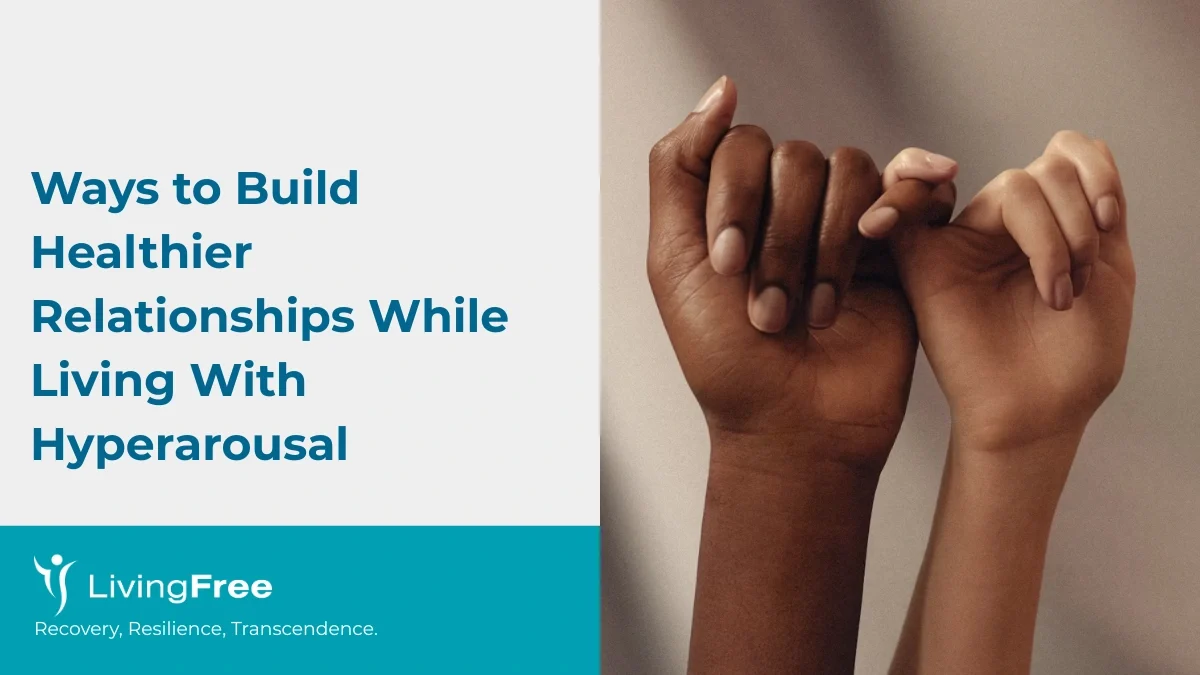Hyperarousal changes the way you experience relationships. Your mind may want connection, but your nervous system often feels unsafe. Your body reacts quickly, even when the moment is calm.
At Living Free, this is understood as a self-protection response. When your system detects threat, it prepares to protect you through fight, flight, freeze, or appease. This response was adaptive in past environments. Today, it can make partnership and closeness feel confusing or overwhelming.
You are not broken. You are living with a nervous system that learned to survive without predictability or safety.
You can still build healthy, stable relationships. You only need tools that help both you and your partner feel grounded, understood, and safe.
Below are ten practical, clinically informed ways to support healthier relationships while living with hyperarousal.
1. Understand Your Hyperarousal Patterns
Hyperarousal impacts how you interpret tone, body language, conflict, and emotional closeness. Knowing your patterns reduces shame and increases compassion for yourself and others.
Common patterns include:
- Feeling tense when conversations become emotional
- Interpreting neutral feedback as criticism
- Shutting down or going blank when overwhelmed
- Becoming reactive or defensive during conflict
- Difficulty staying present when someone expresses needs
- Assuming abandonment or rejection is coming
- Craving closeness but feeling suffocated by it
These patterns are nervous system habits, not character flaws. Your body reacts faster than your mind can interpret.
Script you can use:
“I sometimes respond quickly because my body goes into protection mode. I am learning to notice this earlier.”
2. Identify and Manage Triggers Together
Hyperarousal is often intensified by specific triggers. These may include loud noises, sudden movements, certain words, criticism, facial expressions, or emotional tone.
Triggers are not your fault. They are conditioned associations formed in moments when you did not feel safe.
To identify triggers, you can:
- Notice what escalates your heartbeat or tension
- Track moments when you feel instantly defensive or numb
- Observe what causes you to withdraw or shut down
- Write down patterns without judging yourself
- Share these with a trusted partner when you both feel calm
Script:
“I feel overwhelmed when voices get louder. If that happens, I need us to take a slower pace.”
3. Regulate Your Nervous System Before Responding
You cannot communicate well when your body feels unsafe. Regulation needs to happen before problem-solving or emotional conversations.
Simple regulation tools include:
- Slow breathing: Inhale gently through your nose, exhale longer through your mouth.
- Grounding through the senses: Use the 5-4-3-2-1 method to notice what you see, feel, hear, smell, and taste.
- Body awareness: Feel your feet on the ground, relax your jaw and shoulders, or place a hand on your chest.
- Gentle movement: Shake out your hands or stretch to release tension.
Script for taking a pause:
“I want to respond thoughtfully, but my body feels overwhelmed. I need a minute to settle so I can hear you clearly.”
4. Communicate Clearly and Gently
Hyperarousal affects tone, pacing, and clarity. Calm communication helps prevent misinterpretation.
Use short, simple sentences. Avoid long explanations or fast speech, especially when you feel activated. “I” statements reduce defensiveness and keep the focus on your experience rather than blame.
Examples:
- “I feel tense when the conversation gets louder.”
- “I get overwhelmed when plans change suddenly.”
- “I need a slower pace when we talk about this.”
Grounding script:
“I care about this conversation. My system is reacting, not my intentions.”
5. Set Clear Boundaries for Safety and Predictability
Boundaries are essential for both partners. They create a sense of structure that helps the nervous system relax.
Healthy boundaries might include:
- Agreeing to take breaks during conflict when either person feels overwhelmed
- Setting limits around name-calling, yelling, or criticism
- Having designated quiet time or alone time to regulate
- Clarifying expectations for messages, calls, or time together
- Creating guidelines for how and when to discuss difficult topics
Boundaries protect connection. They are not walls. They are signals of safety and clarity.
Script:
“When I feel overwhelmed, I need a short pause. I will come back. I am not abandoning the conversation.”
6. Practice Consistent Self-Care
Your relationships improve when your nervous system has regular opportunities to reset. Self-care is not selfish. It is essential for regulation.
Supportive practices include:
- Keeping a consistent sleep schedule
- Engaging in regular exercise or gentle movement
- Reducing caffeine, nicotine, and alcohol, especially in the evening
- Spending time in nature or in calming environments
- Maintaining hobbies and activities that bring calm or pleasure
A regulated body interacts with others more calmly, compassionately, and clearly.
Script:
“I am taking care of my body so I can show up better in this relationship.”
7. Use Emotional Regulation Techniques Day-to-Day
Emotional regulation techniques give you practical ways to respond when hyperarousal rises. The aim is not to suppress your feelings, but to help your system feel safe enough to process them.
Helpful techniques include:
- Deep breathing exercises: such as 4-7-8 breathing or gentle paced breathing.
- Mindfulness meditation: bringing attention back to the present moment without judgment.
- Grounding techniques: like the 5-4-3-2-1 senses exercise to orient to the here and now.
- Progressive muscle relaxation: tensing and releasing different muscle groups.
- Self-compassion practices: speaking kindly to yourself when your system is activated.
Living Free emphasises that safety is a sensory experience, not just a thought. Your system needs to feel calm before it can think clearly.
Script:
“When I regulate first, I can understand and communicate much better.”
8. Build a Support Network Beyond Your Partner
Your partner cannot be your only source of safety and support. A broader network helps reduce pressure on the relationship and improves your overall resilience.
Your support network might include:
- Trauma-informed friends who can listen without judgment
- A therapist or counselor who understands hyperarousal
- Support groups, online or in person, for trauma survivors or people with PTSD
- Trusted family members who respect your boundaries
Social support makes it easier to manage stress and decreases the sense of isolation that can accompany hyperarousal.
Script:
“I want to stay connected with you, and I also need other people in my support circle. It helps my nervous system feel more balanced.”
9. Involve Your Partner in Calm, Informed Ways
If you are in a relationship, your partner plays an important role. They do not need to “fix” you. Instead, they can help create an environment of steadiness, understanding, and predictability.
For the Partner
- Listen without judgment: Offer an empathetic, non-judgmental ear when your partner talks about their experience.
- Be consistent and predictable: Keep your promises, follow through on plans, and be reliable. This helps build trust and a sense of safety.
- Learn about hyperarousal: Educate yourself so you can understand that many reactions are symptoms, not personal attacks.
- Help create a calm environment: Be mindful of loud noises, sudden movements, or chaotic settings that may trigger your partner.
- Do not take it personally: Remember that your partner’s hyperarousal is often a response to past trauma, not a measure of your worth.
- Encourage professional help: Gently support your partner in seeking therapy, and consider couples work if it feels appropriate.
Partner script:
“I know your body reacts quickly. I am not against you. I am here with you, and we can slow down together.”
For the Individual With Hyperarousal
- Practice emotional regulation techniques: Use breathing, mindfulness, and grounding tools when you feel overwhelmed.
- Identify and manage triggers: Notice what intensifies your hyperarousal and talk about it with your partner.
- Communicate openly and honestly: Use “I” statements to describe how you feel without blaming.
- Prioritise self-care: Maintain routines that support your physical and mental health.
- Seek professional help: Therapies such as CBT, EMDR, or somatic approaches can provide structure and tools.
- Build a support network: Connect with others who understand, so you do not feel alone in the experience.
Script:
“I am working on my triggers and nervous system. Your understanding helps, but I know this is my healing journey too.”
For Both Partners Together
Healthy relationships grow when both people see hyperarousal as something you face together, not a problem that belongs to just one person.
- Set clear boundaries: Agree on boundaries for space, communication, and conflict so both feel secure.
- Focus on the “we” in problem-solving: Approach stressors as a shared challenge.
- Schedule quality time: Make time for enjoyable, “normal” activities that are not focused on trauma or symptoms.
- Practice patience and self-compassion: Healing is a process for both individuals and the relationship.
- Develop co-regulation habits: Sit together, breathe slowly, or hold hands if it feels safe, so both nervous systems can settle.
Joint script:
“We are both affected by this, and we can approach it as a team. We will go slowly and kindly.”
10. Seek Professional Support When Needed
Some relational patterns are difficult to shift alone. Trauma-informed therapists can help you understand your nervous system, process past experiences, and create new patterns of safety and connection.
Helpful approaches include:
- Eye Movement Desensitisation and Reprocessing (EMDR)
- Somatic Experiencing
- Polyvagal-informed therapy
- Trauma-focused Cognitive Behavioural Therapy (CBT)
- Attachment-focused or emotionally focused couples therapy
Therapy is not about fixing who you are. It is about supporting a nervous system that did not have enough safety in the past.
Script:
“I am noticing patterns I cannot shift on my own. I am ready for help that supports my body and my relationships.”
Building Connection While Living With Hyperarousal
Healthier relationships are possible, even when hyperarousal is part of your story. They require communication, structure, body awareness, and shared responsibility.
Your nervous system learned to stay on guard because it had to survive. With support and new skills, it can gradually learn what safety, presence, and closeness feel like.
You deserve relationships that feel steady, kind, and nourishing. Your partner deserves clarity and connection. With practice, you can both move toward this together.
Related Reading
- Hyperarousal and Relationships: When Safety Feels Impossible
- Are You Experiencing Hyperarousal?
- What Causes Hyperarousal? Understanding the Body’s Alarm System
- How to Calm a Hyperaroused Nervous System
- The Six Domains of Trauma Recovery
- Why Eliminating Triggers Does Not Work in Trauma Recovery
- Psychological Trauma
- Diagnosis and Treatment of Psychological Trauma


